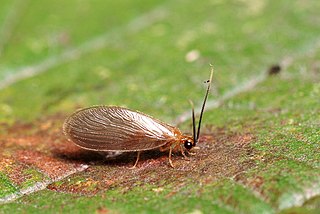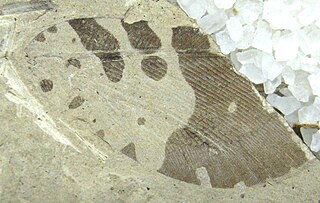
Osmylidae are a small family of winged insects of the net-winged insect order Neuroptera. The osmylids, also called lance lacewings, stream lacewings or giant lacewings, are found all over the world except North and Central America. There are around 225 extant species.

Hemerobiidae is a family of Neuropteran insects commonly known as brown lacewings, comprising about 500 species in 28 genera. Most are yellow to dark brown, but some species are green. They are small; most have forewings 4–10 mm long. These insects differ from the somewhat similar Chrysopidae not only by the usual coloring but also by the wing venation: hemerobiids differ from chrysopids in having numerous long veins and forked costal cross veins. Some genera are widespread, but most are restricted to a single biogeographical realm. Some species have reduced wings to the degree that they are flightless. Imagines (adults) of subfamily Drepanepteryginae mimic dead leaves. Hemerobiid larvae are usually less hairy than chrysopid larvae.

Psychopsidae is a family of winged insects of the order Neuroptera. They are commonly called silky lacewings.

Sisyridae, commonly known as spongeflies or spongillaflies, are a family of winged insects in the order Neuroptera. There are approximately 60 living species described, and several extinct species identified from the fossil record.

Archiinocellia is an extinct genus of snakefly in the family Raphidiidae known from Eocene fossils found in western North America. The genus contains two species, the older Archiinocellia oligoneura and the younger Archiinocellia protomaculata. The type species is of Ypresian age and from the Horsefly Shales of British Columbia, while the younger species from the Lutetian Green River Formation in Colorado. Archiinocellia protomaculata was first described as Agulla protomaculata, and later moved to Archiinocellia.
Microberotha is an extinct monotypic genus of "beaded lacewing" in the family Berothidae known from a fossil found in North America. When described the genus contained a single Ypresian-age species Microberotha macculloughi.

Allorapisma is an extinct genus of lacewing in the moth lacewings family Ithonidae. The genus is solely known from two Eocene fossils found in North America. At the time of description the genus was composed of a single species, Allorapisma chuorum.
Neoephemera antiqua is an extinct species of square-gill mayfly in the family Neoephemeridae that is known from early Eocene, Ypresian stage, lake deposits near the small community of Republic in Ferry County, Washington, USA.

Undulopsychopsis is an extinct genus of lacewing in the silky lacewing family Psychopsidae. The genus is solely known from a Cretaceous fossil found in China. Currently the genus is composed of a single species, Undulopsychopsis alexi.

Elektrithone is an extinct genus of lacewing in the moth lacewings family Ithonidae. The genus is solely known from an Eocene fossil forewing found in Europe. At the times of description the genus was composed of a single species, Elektrithone expectata.
Principiala is an extinct genus of lacewing in the moth lacewings family Ithonidae. The genus is known from Cretaceous fossils found in South America, Europe, and possibly Asia. The genus is composed of two species, the type species Principiala incerta, and Principiala rudgwickensis.
Wesmaelius mathewesi is an extinct species of lacewing in the neuropteran family Hemerobiidae known from an Eocene fossil found in North America
Cretomerobius is an extinct genus of lacewings in the neuropteran family Hemerobiidae known from fossils found in Asia. The genus currently contains a single species, the Aptian C. disjunctus.

Makarkinia is an extinct genus of lacewings in the family Kalligrammatidae described by Martins-Neto in 1997 from fossils found in the Crato Formation of the Araripe Basin in northeastern Brazil. The genus contains three species dating to the Late Aptian, Makarkinia adamsi, Makarkinia kerneri and Makarkinia irmae.
Burmaleon is an extinct genus of lacewing in the family Osmylidae known from fossils found in Asia. The genus contains a single species, Burmaleon magnificus.

Palaeopsychops is an extinct genus of lacewing in the moth lacewings family Ithonidae. The genus is known from Early Eocene fossils found in Europe, and North America and is composed of ten species. The ten species can be informally separated into two species groups based on veination of the forewings, the "European" and "North American" groups. When first described, the genus was placed in the family Psychopsidae, but later was moved to Polystoechotidae, which itself is now considered a subgroup of the moth lacewings.

Polystoechotites is an extinct parataxon of lacewings in the moth lacewing family Ithonidae. The taxon is a collective group for fossil polystechotid giant lacewing species whose genus affiliation is uncertain, but which are distinct enough to identify as segregate species. Polystoechotites species are known from Eocene fossils found in North America and is composed of four named species Polystoechotites barksdalae, Polystoechotites falcatus, Polystoechotites lewisi, and Polystoechotites piperatus, plus two unnamed species. Three of the described species are known from fossils recovered from the Eocene Okanagan Highlands of Washington State, while the fourth is from Colorado.

Republicopteron is an extinct orthopteran genus in the katydid-like family Palaeorehniidae with a single described species, Republicopteron douseae.

Okanagrion is an extinct odonate genus in the damselfly-like family Dysagrionidae. The genus was first described in 2021 with a series of eight species included from early Eocene Okanagan Highlands sites in western North America. The genus is known from the Late Ypresian sediments exposed in northeast central Washington at Republic where five species are present, and from the coeval McAbee Fossil Beds near Cache Creek in Central British Columbia, where four species are present. The species richness is attributed to high latitude high alpha diversity resulting from climatic equitability during the Early Eocene in combination with resultant beta diversity between sites due to impassible topographical barriers.

Republica is an extinct zygopteran genus in the damselfly family Euphaeidae with a single described species, Republica weatbrooki. The species is solely known from the Early Eocene sediments exposed in the northeast of the U.S. state of Washington.














